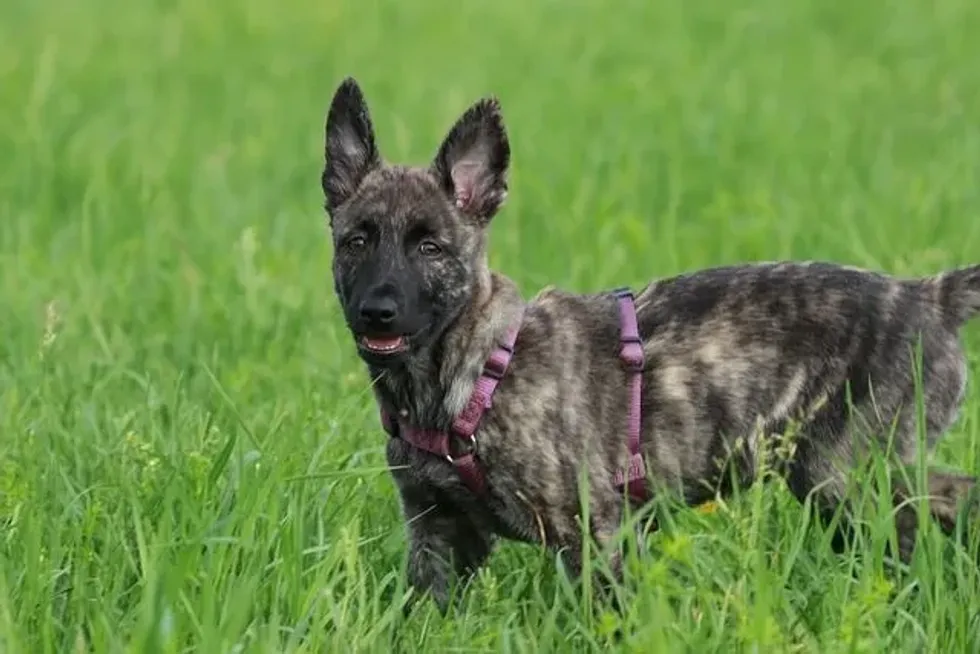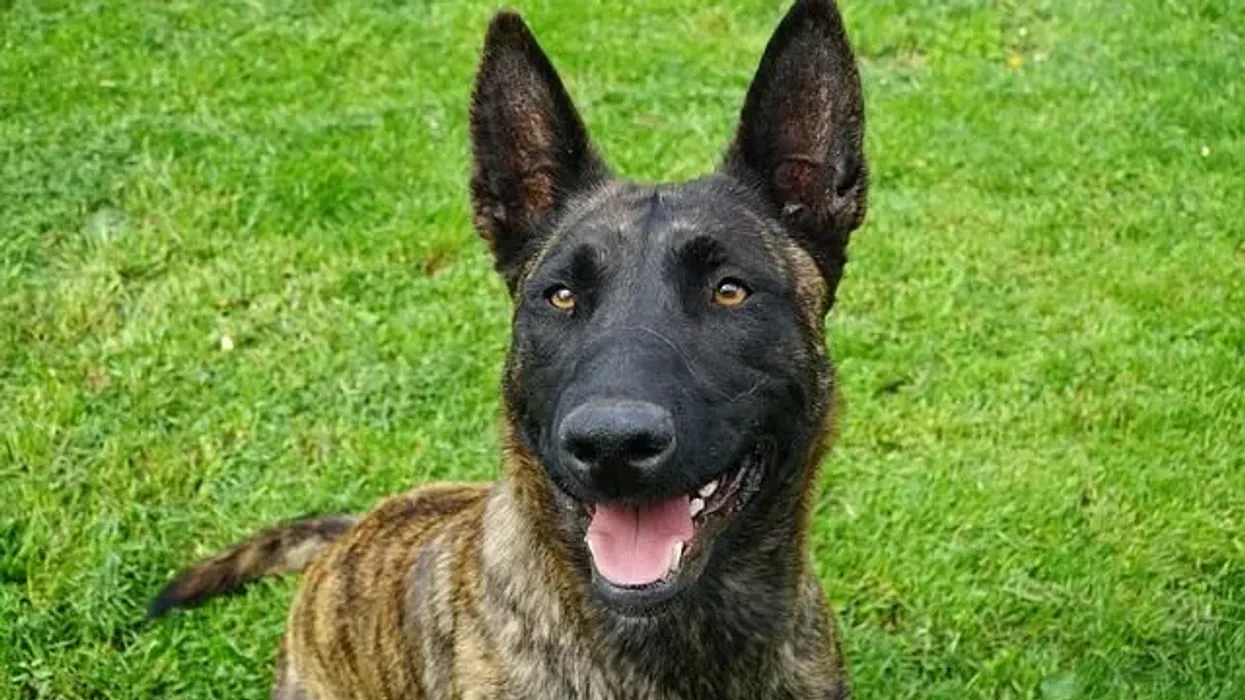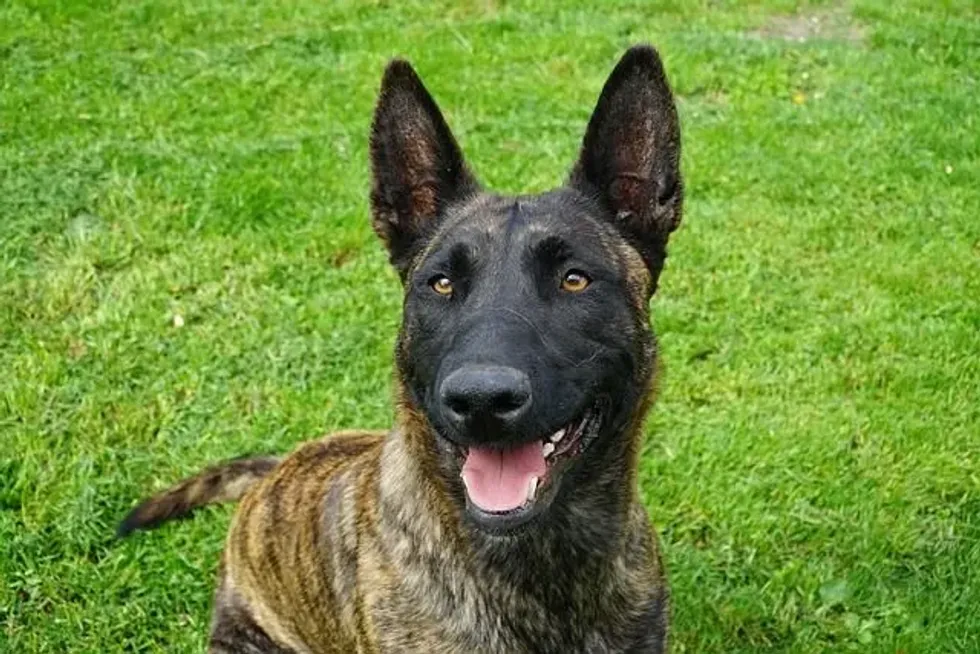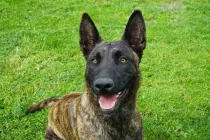Fun Dutch Shepherd Facts For Kids

The Dutch Shepherd breed is a breed of very good search and rescue mission dogs. This beautiful dog has three variations, long-haired, rough-haired (famously known as wire-haired), and short-haired.
This breed is found in either a silver brindle or golden brindle color, but the silver brindle color-haired variety is very rare.
They can be found on countryside farms maintaining flocks of sheep, keeping hens away from the kitchen, and even herding cows together for milking, but these dogs are also popular domestic pets that are commonly found living in humans' homes.
The Dutch Shepherd is an independent breed, with its origin in the Netherlands and these dogs are popular as they are excellent herding dogs.
They are also popularly used as guard dogs.
The breed standards of a Dutch Shepherd make it a vivacious and intelligent dog, and this also makes it a brilliant police dog or working dog. One interesting fact about the Dutch Shepherd breed is that males of the breed tend to be bigger than females.
Keep reading this article to find out more about Dutch Shepherd puppies, the long-haired Dutch Shepherd, the short-hair Dutch Shepherd, the different Dutch Shepherd colors, Dutch Shepherd shedding, and more. You may also check out our fact files on the Anatolian Shepherd and the White German Shepherd to learn more about other dog breeds.
Dutch Shepherd Interesting Facts
What type of animal is a Dutch Shepherd?
The Dutch Shepherd is a beautiful and quite rare breed of dog. It is a medium-sized dog breed that shows similarities with its cousins, the Belgian Shepherd and the German Shepherd.
What class of animal does a Dutch Shepherd belong to?
The Dutch Shepherd dog belongs to the class Mammalia.
How many Dutch Shepherds are there in the world?
There are approximately 2,000 to 2,500 Dutch Shepherds in the world that are registered under the FCI. This organization only accepts pure Dutch breeds.
Where does a Dutch Shepherd live?
The Dutch Shepherd can be found living on countryside farms where they help to look after livestock and act as watchdogs. They are a popular dog in the Netherlands.
What is a Dutch Shepherd's habitat?
A Dutch Shepherd's natural habitat is in the Dutch countryside as a working dog for shepherds. However, today, they are most commonly found in the homes of their owners.
Who do Dutch Shepherds live with?
A Dutch Shepherd dog lives with its family of humans.
How long does a Dutch Shepherd live?
Dutch Shepherd dogs have a lifespan ranging from 11 to 14 years.
How do they reproduce?
Dutch Shepherds, just like any other mammals, reproduce through sexual reproduction. The gestation period of this dog is approximately 63 days long, and their litter sizes can vary from six to 10 puppies at a time.
What is their conservation status?
Although they are not listed in the IUCN Red List, this breed has become rarer in modern times. The advent of new farming techniques has resulted in the reduction of the need for shepherd dogs, meaning that this breed has slightly lost its purpose.
At present, Dutch Shepherds often find themselves in the posts of police dogs, helping out in search and rescue missions. They are also used as herding dogs and as guide dogs thanks to their high trainability.
They are also sometimes used to compete in various sports events for dogs.
However, despite this, the breed is still a rare breed today. As it is a rare breed, it becomes costly (a German Shepherd puppy costs approximately between $3,000 and $7,000).
Dutch Shepherd Fun Facts
What do Dutch Shepherds look like?
Short-hair, wire-haired (more commonly known as rough-haired), and long-haired are the three different coat types that this dog breed can have. A woolly undercoat can be found on the short-haired variety of the breed, whereas the wire-haired (or rough-haired) Dutch breed has a high-density coat with a coarse texture as well as a woolly undercoat.
The long-hair breed has a rough texture but a longer, straight coat type. Dutch Shepherd dogs are very comfortable in a majority of weather conditions due to their hardy coats.
Their body color is generally brindle comprising of different shades of silver and gold, and these shades vary from light and sandy to red. Apart from the wire-haired variety, also commonly known as rough-haired Dutch Shepherds, these dogs need regular grooming and plenty of brushing to keep their undercoats clean and to remove any dead hairs.
They should be bathed as and when required to replenish their natural oils too.

How cute are they?
A Dutch Shepherd dog is super cute, especially as a puppy. They are also a very disciplined and intelligent breed of dogs, just like their cousins, German Shepherds, and Belgian Shepherds.
How do they communicate?
Dutch Shepherd dogs communicate in lots of different ways, but primarily through howling. Dutch Shepherds are quiet dogs and they vocalize only when necessary. These vocalizations can be an act of protection against a threatening situation or an irregularity in its surroundings or simply a way to express feelings.
How big is a Dutch Shepherd?
Males of this dog breed are comparatively larger than females. Males stand 23-25 in (58-64 cm) long and females are 22-24 in (56-61 cm) in size. The Dutch Shepherd is almost four to five times larger than the Chihuahua, one of the most miniature dog breeds.
How fast can a Dutch Shepherd run?
Dutch Shepherd dogs can run at a maximum speed of 32 mph (51 kph). This makes them quick dogs that are ideal for search and rescue missions. They are also ideal to be kept as police dogs as they are fast, agile, and highly trainable. These dogs are almost three times faster than domestic pigs.
How much does a Dutch Shepherd weigh?
Dutch Shepherd dogs are medium-sized breeds just like their cousins the German Shepherd and Belgian Malinois dogs. The breed weighs around 50-70 lb (23-32 kg). These are standard sizes, but some individuals in the species may be larger or smaller. A Dutch Shepherd weighs 20 to 30 times more than Fennec's foxes do.
What are the male and female names of the species?
A dog is a general term used to refer to all animals of this species, but the name 'dog' refers to males specifically, while females are called a 'bitch'.
What would you call a baby Dutch Shepherd?
A baby Dutch Shepherd is called a 'puppy'.
What do they eat?
The diet of the Dutch Shepherd dog breed should seek to replicate a natural and raw diet with appropriate nutrition. High-quality dry dog food provides this breed with balanced nutrition, along with canned food, and a small (but very important) portion of treats!
Some fruits and vegetables are also suitable for them, and they love cheese too. They also love raw meat and bones. These treat foods should be less than 10% of a German Shepherd's daily nutrition intake.
Are they hypoallergenic?
Dutch Shepherds are not hypoallergenic. They don't do well with allergy sufferers and can cause an allergic reaction in humans. These reactions occur because of dander (flakes on the dog's skin), so the dog's hair and coat types are largely irrelevant. Regular grooming and brushing can help avoid the problem.
Would they make a good pet?
Dutch Shepherds make excellent pets and are great for first-time owners as well as experienced dog owners. They are intelligent, agile, and highly trainable, which makes them perfect family dogs.
These dogs are a social breed and enjoy being around people as well as other animals. This dog breed is an ideal choice for people who are looking for a quiet breed and they are also good watchdogs.
They can be vocal at certain times though, whether they are seeking protection or are suffering from separation anxiety. They are very unlikely to bite humans, and only bite when provoked by their herding dog instinct.
They are also apartment-friendly dogs, and they don't mind being inside as long as you walk them several times a day. They need regular exercise throughout their life to keep them healthy.
If they do not get enough exercise, they will become weak, get a dull coat and develop higher chances of health issues. These dogs adapt well to changes in their environmental conditions but don't tolerate being left alone for long periods well.
Although they make great pets, they also make great working dogs. This breed is used as a sniffer and detection dog to detect specific substances such as explosives, illegal drugs, currency, and electronics. They are also utilized for search and rescue operations.
Did you know...
One interesting fact about Dutch Shepherd dogs is that they once faced extinction. This is because an increase in the use of modern farming machinery led to a fall in demand for this breed. Luckily, the breed has largely overcome this challenge and, today, multiple kennel clubs register this breed.
The Dutch Shepherd is generally a healthy breed, but there are some specific health problems that this breed faces. There are certain instances of Dutch Shepherd breed dogs developing hip dysplasia, inflammatory bowel disease, and masticatory myositis. Owners should ensure that their Dutch Shepherd has regular check-ups with a vet to look out for these conditions.
Dutch Shepherds are relatively easy to train, as long as you use lots of positive reinforcement.
Is a Dutch Shepherd a Belgian Malinois?
The Dutch Shepherd breed is similar to the Belgian Malinois breed and both breeds of dog have been bred for hard work. Belgian Malinois dogs are recognized as a confident, smart, and hardworking breed, whereas Dutch Shepherds are recognized for being innovative, intelligent, lively, and aesthetic.
Both breeds are similar in size and stature and are, therefore, often mislabeled.
The Belgian Malinois origin can be traced back to the city of Malines on the outskirts of the Belgian capital, Brussels. In contrast, Dutch Shepherds are native to the Netherlands and were historically used by shepherds and farmers.
In terms of their appearance, Belgian Malinois dogs are leggier and are strong working dogs with strong bones, well-built muscles, and streamlined bodies. Their coat color ranges from rich fawn to mahogany with black ears and dark eyes.
On the other hand, Dutch Shepherds have a brindle coat and a black mask that gives them a wolf-like appearance. Their coats can be short-haired, long-haired, or rough-haired (you can also call this a wire-haired Dutch Shepherd).
Temperament-wise, Dutch Shepherds are well-balanced, intelligent, and obedient and make great service animals. In contrast, Belgian Malinois are confident but are reserved with strangers and develop a deep bond with their owners.
They are not aggressive if they are well-trained and exercised regularly. Like Dutch Shepherds, they are very friendly and have a malleable temperament. Therefore they easily get along with kids and other dogs if they are introduced at a young age.
Why have a Dutch Shepherd instead of a German Shepherd?
Another breed that is very similar to Dutch Shepherds is the German Shepherd. German Shepherds are much more people-oriented and are easier to train, whereas Dutch Shepherds are independent and are more of a working dog breed.
There are very few differences appearance-wise, and both breeds are of the same size and stature. For people who want more of a working dog, rather than a family dog, you might prefer Dutch Shepherds.
Here at Kidadl, we have carefully created lots of interesting family-friendly animal facts for everyone to discover! Learn more about some other mammals including the Australian Shepherd, or the Miniature German Shepherd.
You can even occupy yourself at home by drawing one on our Dutch Shepherd coloring pages.
We Want Your Photos!
More for You
See All
Bachelor of Science specializing in Human Anatomy

Joan AgieBachelor of Science specializing in Human Anatomy
With 3+ years of research and content writing experience across several niches, especially on education, technology, and business topics. Joan holds a Bachelor’s degree in Human Anatomy from the Federal University of Technology, Akure, Nigeria, and has worked as a researcher and writer for organizations across Nigeria, the US, the UK, and Germany. Joan enjoys meditation, watching movies, and learning new languages in her free time.
Bachelor of Science specializing in in Computer Science

Diya PatelBachelor of Science specializing in in Computer Science
A member of Kidadl's fact-checking team, Diya is currently pursuing a degree in Computer Science from Ahmedabad University with an interest in exploring other fields. As part of her degree, she has taken classes in communications and writing to expand her knowledge and skills.
Disclaimer
1) Kidadl is independent and to make our service free to you the reader we are supported by advertising. We hope you love our recommendations for products and services! What we suggest is selected independently by the Kidadl team. If you purchase using the Buy Now button we may earn a small commission. This does not influence our choices. Prices are correct and items are available at the time the article was published but we cannot guarantee that on the time of reading. Please note that Kidadl is a participant in the Amazon Services LLC Associates Program, an affiliate advertising program designed to provide a means for sites to earn advertising fees by advertising and linking to Amazon. We also link to other websites, but are not responsible for their content.
2) At Kidadl, we strive to recommend the very best activities and events. We will always aim to give you accurate information at the date of publication - however, information does change, so it’s important you do your own research, double-check and make the decision that is right for your family. We recognise that not all activities and ideas are appropriate for all children and families or in all circumstances. Our recommended activities are based on age but these are a guide. We recommend that these ideas are used as inspiration, that ideas are undertaken with appropriate adult supervision, and that each adult uses their own discretion and knowledge of their children to consider the safety and suitability. Kidadl cannot accept liability for the execution of these ideas, and parental supervision is advised at all times, as safety is paramount. Anyone using the information provided by Kidadl does so at their own risk and we can not accept liability if things go wrong.
3) Because we are an educational resource, we have quotes and facts about a range of historical and modern figures. We do not endorse the actions of or rhetoric of all the people included in these collections, but we think they are important for growing minds to learn about under the guidance of parents or guardians.







